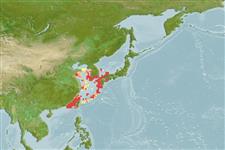Classification / Names
Common names from other countries
Main reference
Size / Weight / Age
Max length : 18.0 cm TL male/unsexed; (Ref. 56557); common length : 10.0 cm SL male/unsexed; (Ref. 188)
Environment
Marine; pelagic-neritic; oceanodromous (Ref. 51243); depth range 5 - ? m (Ref. 12166)
Climate / Range
Subtropical, preferred 22°C (Ref. 107945); 38°N - 22°N, 117°E - 134°E (Ref. 54873)
Distribution
Short description
Dorsal
spines
(total): 0;
Anal
spines: 0. Total scutes 29 to 32. Vertical striae on scales overlapping or continuous (discontinuous in S. fimbriata and S. albella), only a few small perforations on hind part of scale. No dark spot at dorsal fin origin. Most closely resembles S. richardsoni, which has more gill rakers and has a slightly deeper body; S. hualiensis has black tips to dorsal and caudal fins.
IUCN Red List Status (Ref. 115185)
Threat to humans
Harmless
Human uses
Fisheries: highly commercial
More information
ReferencesAquacultureAquaculture profileStrainsGeneticsAllele frequenciesHeritabilityDiseasesProcessingMass conversion
Tools
Special reports
Download XML
Internet sources
Estimates of some properties based on models
Phylogenetic diversity index
PD50 = 0.5000 many relatives (e.g. carps) 0.5 - 2.0 few relatives (e.g. lungfishes)
Trophic Level
3.1 ±0.24 se; Based on food items.
Resilience
High, minimum population doubling time less than 15 months (tm=1)
Vulnerability
Low vulnerability (23 of 100)
Price category
